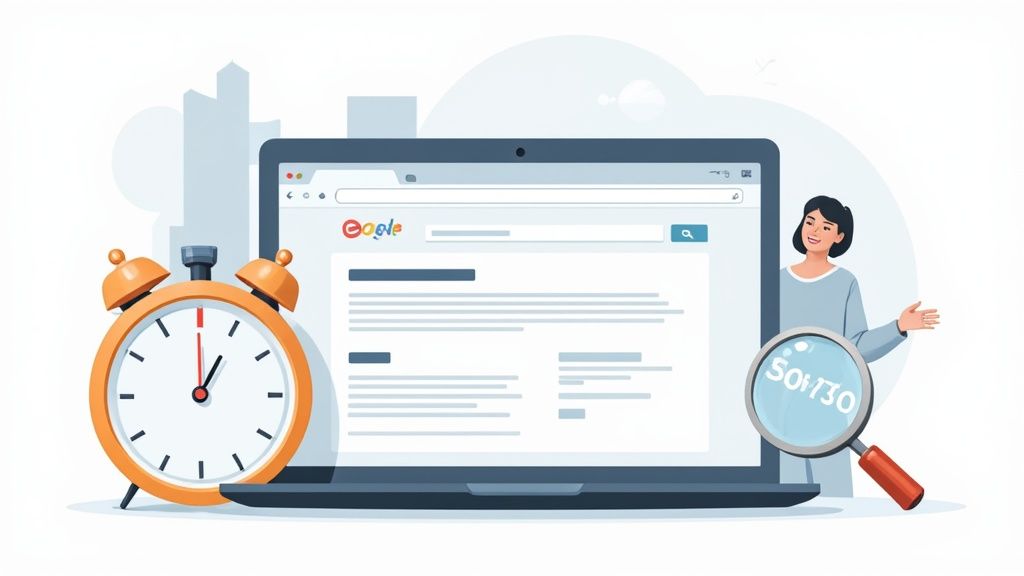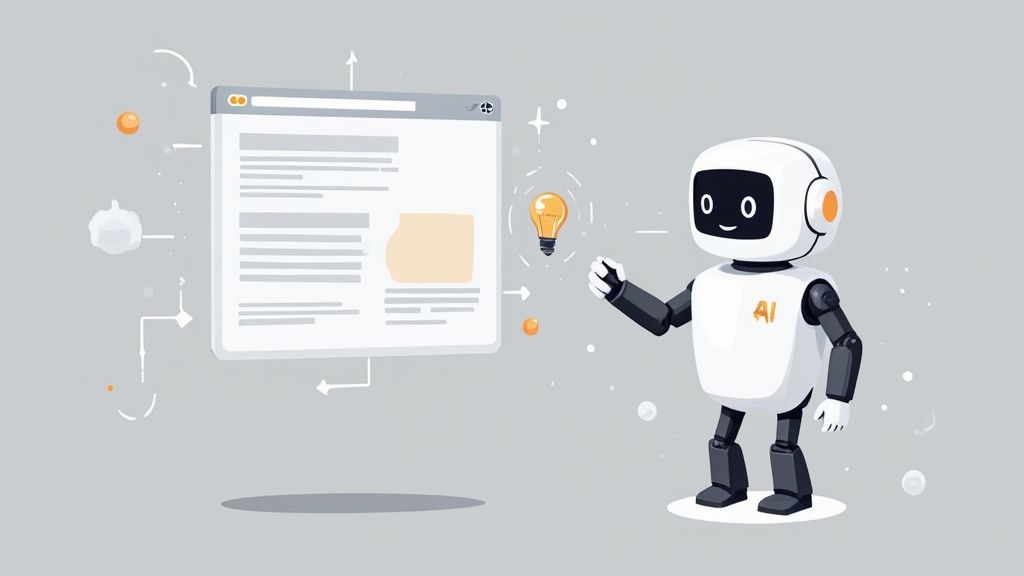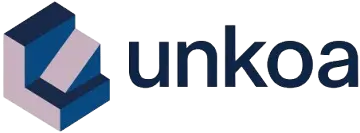How to Do Search Engine Optimization Yourself

Getting started with SEO can feel like trying to drink from a firehose. But here's a little secret: you don't need to know everything to get your first win. Forget the marathon for a second; let's focus on a quick sprint that proves you can make a real impact in under 30 minutes.
This isn't about boiling the ocean. It's about building momentum.
Your First SEO Win in Under 30 Minutes

The biggest thing that holds people back from doing their own SEO is feeling completely overwhelmed. I get it. So, instead of trying to master every little thing at once, we're going to zero in on a single, high-impact action that delivers a result you can actually see.
The goal is dead simple: pick one important page on your site and make it better for both humans and search engines. This small victory will pull back the curtain on the whole process and show you that good SEO is really just a series of deliberate, repeatable steps.
Identify Your Money Page and Keyword
First things first, pick one page on your website that's absolutely critical to your business. This might be a service page, a product page, or that one blog post that actually brings in leads. Don't overthink it. Just choose the page you'd show a new customer if you only had one choice.
Now, give that page a "money keyword." This is the main phrase a real person would type into Google to find what you're offering on that page. If you sell custom logos, your keyword might be "custom logo design services." Get specific and try to think like your customer.
Pro Tip: Your money keyword needs to be realistic. Chasing a hyper-competitive term like "marketing" is a fool's errand. Instead, aim for longer, more specific phrases that show someone is ready to buy, like "content marketing for SaaS startups."
Analyze the Current Winners
Okay, now for a little recon. Open a new incognito browser window (so your search history doesn't influence the results) and search for your money keyword.
Take a good, hard look at the top three organic results. Don't just skim them—dissect what they're doing right.
Pay close attention to these three things:
- Title Tag: This is the main blue link in the search results. How is it phrased? What words jump out?
- Meta Description: The little blurb of text under the title. What benefit are they promising? Is there a call to action?
- H1 Heading: The main headline on their actual webpage. Is it identical to the title tag, or is it a little different?
This quick analysis is gold. It's Google literally telling you what it wants to see for that specific search.
Make Your Optimizations
Armed with this intel, it's time to take action. Head over to your chosen page and tweak three core elements to better match what you just saw from the top-ranking pages.
- Rewrite Your Title Tag: Make it punchy, clear, and get your money keyword in there, preferably near the beginning. Keep it under 60 characters so it doesn't get cut off.
- Update Your Meta Description: Think of this as a mini-ad for your page. Write a concise summary (around 155 characters) of the value inside. Weave the keyword in naturally and answer the user's biggest question.
- Refine Your H1 Heading: Make sure the main headline on your page also features the keyword and perfectly matches the page's content. No bait and switch.
For anyone using a platform like Webflow, making these changes is a breeze. If you're looking for a more detailed walkthrough, our guide shows you how to update meta descriptions and other SEO features on Webflow step-by-step. Making these small but powerful tweaks is your first real step toward mastering how to do search engine optimization yourself.
Building Your SEO Toolkit on a Budget

You don't need a massive software budget to get serious about doing your own search engine optimization. In fact, some of the most powerful tools out there are completely free, while others deliver incredible value without breaking the bank. The trick is to build a small, focused toolkit that covers your bases.
Let's start with the non-negotiables. Before you spend a single dollar, get Google Analytics and Google Search Console set up. These two are the absolute bedrock of any SEO strategy, giving you direct data from Google on how your site is performing, what keywords people are using to find you, and any technical glitches holding you back.
Think of them as your dashboard and diagnostic system. You can't make smart decisions without them.
Choosing Your Core Optimization Tools
Once your foundational analytics are humming along, you can layer in a few specialized tools to handle specific jobs. The goal isn't to collect a dozen subscriptions; it's to find one or two high-leverage platforms that give you a real competitive edge.
For keyword research and actually creating content, a tool like Frase is a game-changer. It helps you analyze what’s already ranking at the top and build data-driven outlines, saving you hours of manual guesswork. This is how you ensure your content is comprehensive and directly answers what searchers are looking for.
Similarly, polishing your writing is crucial for user experience and readability—both are subtle but important ranking factors. An AI writing assistant like QuillBot can help you tighten up sentence structure, check for clarity, and make sure your final draft is professional and easy to read. It’s the final quality check before you hit publish.
Key Takeaway: Your toolkit should be lean and purposeful. Start with the free essentials from Google, then strategically add tools that solve a specific problem in your workflow, like content optimization or writing assistance.
Keeping Your SEO Efforts Organized
When you’re doing SEO yourself, you're also the project manager. Without a system to track tasks and ideas, your efforts can get scattered and you'll lose momentum fast. A simple organizational tool is a must-have.
Here are a couple of excellent, budget-friendly options:
- Notion: This is perfect for creating a flexible SEO hub. You can build out content calendars, track your keyword research, and store all your content briefs in one place.
- Todoist: If you just want a straightforward task manager, Todoist is fantastic for creating recurring SEO checklists and managing deadlines for content and technical fixes.
Whichever you choose, the habit of documenting your plan and tracking your progress is what turns sporadic actions into a consistent, effective SEO strategy. This simple step ensures your valuable time is always spent on the most important tasks.
Mastering the Core Pillars of DIY SEO
Great SEO isn't just one thing. It’s a balancing act across three core areas. When you're figuring out how to do search engine optimization yourself, think of it like a three-legged stool: on-page, off-page, and technical SEO. If you ignore one leg, the whole thing gets wobbly and eventually falls over.
Getting this balance right gives you a framework for everything you do. It helps you decide where to put your limited time and energy for the biggest possible impact.
On-Page SEO: Creating Genuinely Helpful Content
On-page SEO is everything you have direct control over on your own website. For anyone doing SEO themselves, this is the best place to start because the wins are tangible and you can see them almost immediately. But it's about way more than just sprinkling keywords on a page.
The real goal here is to create content that actually solves a problem or answers a question for a real person. That means every single page needs to align with a clear search intent—the "why" behind what someone typed into Google. Our guide on keyword research for small businesses goes way deeper into how to uncover that intent.
Here are a few practical on-page actions you can take right now:
- Logical Structure: Use clear H1, H2, and H3 headings to give your content a clean hierarchy. This makes it easy for both your readers and search engines to understand what's important.
- Optimized Media: Always compress your images to keep your pages loading fast. And don't forget to use descriptive alt text—it tells search engines (and visually impaired users) what an image is all about.
- Clear Writing: Write in short, scannable paragraphs. Nobody wants to read a wall of text. Use bullet points and bold text to make key information pop.
Off-Page SEO: Building Authority and Trust
Off-page SEO covers all the stuff you do outside of your website to improve your rankings. Mostly, this comes down to building authority, and the best way to do that is by earning backlinks from other credible sites in your space.
This is the pillar that usually intimidates people, but it doesn't have to involve sketchy, spammy tactics. Good, sustainable off-page SEO is really about building relationships and creating content that's actually worth sharing. You can start by guest posting on relevant industry blogs or just being genuinely helpful in online communities where your potential customers hang out.
Key Insight: A single backlink from a high-quality, respected website in your niche is worth more than a hundred low-quality links from random directories. It’s always quality over quantity.
Technical SEO: The Foundation of Your Site
Finally, technical SEO is the foundation that makes sure search engines can find, crawl, and index your website without any trouble. It can get pretty complex, but there are a few fundamental checks you can easily handle yourself.
Start with these three basics:
- Site Speed: Use a tool like Google's PageSpeed Insights to see how fast your site loads. A slow site is a frustrating site, and Google hates it.
- Mobile-Friendliness: A massive chunk of all searches happens on a phone. Your site absolutely has to look and work great on a smaller screen.
- XML Sitemap: A sitemap is just a simple list of all your important pages. Submitting it to Google Search Console helps make sure Google doesn't miss anything.
When you're doing search engine optimization yourself, you have to understand the scale of the market you're playing in. By 2025, Google is expected to handle around 16.4 billion searches daily, and it currently owns a mind-boggling 90.06% of the global search market. That dominance means your efforts have to play by Google’s rules to have any chance of success. You can dig into more of these numbers over on Backlinko.
A Realistic Weekly SEO Checklist
Let’s be honest: consistency is what separates SEO strategies that win from those that just fizzle out. When you're learning how to do search engine optimization yourself, it's incredibly easy to get overwhelmed and try to do everything at once. That’s a fast track to burnout.
Your best defense is a sustainable, repeatable checklist. This isn’t about cramming another 20 hours into your workweek. It’s about weaving small, high-impact SEO tasks into your routine so you’re always making steady progress.
Think of it as a continuous cycle. Your on-page, off-page, and technical efforts all feed into each other, creating a powerful flywheel effect over time.

As the flow shows, fixing a technical issue can boost your on-page rankings, which in turn makes your off-page outreach more effective. Everything is connected.
Your Sustainable SEO Cadence
The secret is breaking down the mountain of "SEO stuff" into manageable chunks. Some tasks are weekly, others are monthly. Sticking to a simple schedule like this stops SEO from becoming that thing you'll "get to eventually."
To help you stay on track, here's a simple breakdown of the essential tasks and their frequency.
Your DIY SEO Action Plan
| Frequency | Task | Objective |
|---|---|---|
| Weekly | Review Keyword Performance | Jump into Google Search Console and find keywords where you rank on page 2. These are your low-hanging fruit—perfect targets for a quick optimization win. |
| Weekly | Find One New Content Idea | What are your customers asking? What problems are people debating on forums? Find one real question you can answer with a blog post. |
| Weekly | One Outreach Activity | Just 30 minutes. That's it. Answer a HARO query, leave a thoughtful comment on a relevant blog, or share another expert's content. Small actions compound. |
| Monthly | Run a Quick Site Scan | Use a free tool to hunt down and fix broken links. This is a simple way to improve user experience and make Google’s job easier. |
| Monthly | Analyze Top Performing Content | Open up Google Analytics. Find out what's already working and figure out how you can double down—can you update it, expand it, or create a follow-up piece? |
This plan provides a clear, actionable framework to keep your SEO efforts consistent without overwhelming your schedule.
Prioritizing Your Time
As a solopreneur or small business owner, your time is gold. This checklist isn’t meant to be a rigid set of rules; it's a framework. If you have a crazy week and all you can manage is a quick keyword review, that’s perfectly fine. You kept the ball rolling.
Key Takeaway: Progress over perfection is the mantra for DIY SEO. Consistently executing a few core tasks each week will compound into significant results over time, far more than sporadic bursts of intense effort.
For example, finding one new content idea every week gives you a backlog of 52 relevant topics after a year. To make that even easier, you can plug those ideas directly into a solid SEO content brief workflow to turn them into articles that actually rank.
This consistency pays off. Big time. According to the 2025 State of SEO Survey, organic search delivers an average of 33% of all website traffic. The same full State of Organic Marketing report found that a staggering 91% of businesses reported that SEO had a positive impact on their performance. It just works when you work it.
Using AI to Supercharge Your SEO Efforts

Let's be honest: trying to do SEO yourself can feel like you're bringing a knife to a gunfight. You're up against entire teams with huge budgets. Artificial intelligence is the modern DIYer's secret weapon—it’s how you even the odds.
For anyone trying to figure out how to do search engine optimization yourself, AI tools are a massive force multiplier. They automate the soul-crushing, tedious tasks that used to eat up countless hours.
This isn't about letting a robot write your entire strategy. It's about strategically offloading the repetitive work so you can focus on the high-level thinking that actually moves the needle. Think of AI as your endlessly patient assistant, ready to do the heavy lifting.
Automating Research and Content Outlining
One of the biggest time sinks in SEO is just figuring out what to write. You have to dissect competitor content, spot common subtopics, and uncover the real questions your audience is asking. This used to be a multi-hour manual slog. Now, AI can do it in minutes.
A tool like Frase is a perfect example of this in action. Feed it a target keyword, and it instantly analyzes the top-ranking pages to spit out a comprehensive, data-driven content outline. It pulls in common headings, related topics, and frequently asked questions, giving you a solid blueprint to build from.
This simple step automates the grunt work and ensures your content is more thorough than your competitors' from the get-go. When your time is your most valuable asset, that’s a huge advantage.
Refining and Polishing Your Writing
Once you have a draft, AI can help you whip it into shape. It's your on-demand editor for improving clarity, tone, and readability—all critical factors for user engagement and, by extension, search rankings.
An AI writing assistant like QuillBot is great for this. It helps you rephrase clunky sentences, find stronger words, and catch grammatical errors that you might have missed. It’s the difference between publishing something that’s “good enough” and something that’s genuinely polished and professional.
Key Insight: The goal here isn't to replace your voice, but to amplify it. Use AI as a final quality-control step. It will catch mistakes and smooth out the flow of your arguments, making your content hit harder with readers.
This isn't just a fringe tactic anymore; it's rapidly becoming standard practice. By 2025, industry surveys show that 86% of SEO professionals will have integrated AI into their workflows. Why the rush? Because 75% of marketers are already using AI to slash manual work, and 65% of businesses report seeing better SEO results after bringing AI tools on board. You can discover how AI is reshaping SEO workflows and see more of the data for yourself.
Practical AI Applications for DIY SEO
So, what does this look like in the real world? Here are a few specific, actionable ways to use AI to make your SEO efforts much more efficient:
- Brainstorming Content Topics: Stuck for ideas? Ask an AI to generate dozens of blog post titles, FAQs, and subtopics around your main keywords. It’s an instant cure for writer's block.
- Drafting Meta Descriptions: Writing unique, compelling meta descriptions for every single page is a real chore. AI can generate several options for you to quickly choose from and tweak.
- Generating Keyword Clusters: Instead of just hunting for single keywords, ask an AI to group related terms into thematic clusters. This is a much smarter way to build topic authority.
- Summarizing Research: Found a long competitor article or a dense study? Drop it into an AI and ask for a concise summary. This is a massive time-saver during the research phase.
By embracing these tools, you can automate the most time-consuming parts of SEO, allowing you to execute a surprisingly sophisticated strategy, even on a solo budget.
A Few Common Questions about DIY SEO
Jumping into SEO on your own can feel like you're learning a whole new language. As you start putting these strategies into action, you're bound to have questions. This last section is all about tackling the most common ones I hear from people managing their own search optimization, with clear, straight-up answers to keep you moving.
How Long Does This Stuff Actually Take to Work?
You might see some small, encouraging wins pretty quickly—like watching a page hop from position 20 to 15 after that initial 30-minute blitz. That's great, but the big, traffic-driving results? Those typically take 3 to 6 months to really show up.
A lot depends on how competitive your industry is, your site's current authority, and how consistently you stick with it. Think of SEO as a long-term investment, not a get-rich-quick scheme. Following the weekly checklist is what builds real, lasting traffic over time. Patience is the name of the game here.
Key Takeaway: SEO is a marathon, not a sprint. The first few weeks are for laying the groundwork. The real growth comes from consistent, focused effort over several months, so don't get discouraged if you're not a superstar in month one.
I'm a Beginner. What Should I Focus on First?
For anyone just starting out, your highest-impact move is focusing on on-page SEO and content creation. Why? Because you have 100% control over these things from day one. You don't need anyone's permission to make your own website better.
Start by getting a deep understanding of what your audience is actually searching for. Once you know that, your main job is to create top-notch content that answers their questions better than anyone else on the internet. If you can master title tags, headers, and the art of writing genuinely helpful articles, you're building a foundation that search engines are designed to reward.
Can I Really Do SEO Myself Without Hiring an Expert?
Absolutely. While a seasoned expert can often speed things up, learning how to do search engine optimization yourself is completely doable. This is especially true for small businesses, freelancers, and personal brands who don't have a massive budget or a complex toolkit.
Success really boils down to the fundamentals: creating valuable content for a specific group of people and sticking to a consistent routine. The tools and strategies in this guide—from mapping out a content plan in Notion to checking out competitors with Frase—are all designed to give you what you need to grow on your own terms.
What Are the Biggest Mistakes People Make?
The most common traps in DIY SEO are surprisingly easy to fall into. Keep an eye out for these big ones:
- Keyword Stuffing: Don't just jam keywords where they don't fit. It makes your content sound robotic and weird. Always write for humans first, search engines second.
- Ignoring the Technical Basics: A slow site or a clunky mobile experience will kill your user experience. If visitors get frustrated and leave, Google sees that as a bad sign.
- Chasing Rankings Instead of Helping People: Your goal isn't just to hit #1; it's to solve the user's problem. If you focus on creating the best possible answer, the rankings have a funny way of following.
- Giving Up Too Soon: This is the most common mistake, hands down. So many people quit after a month or two because they aren't seeing massive results. Stick with it—the compound effect of your effort is incredibly powerful.





